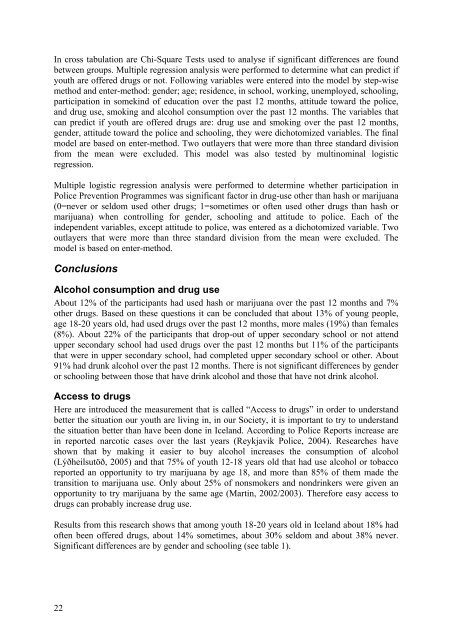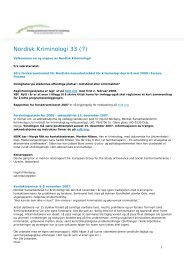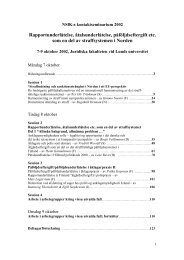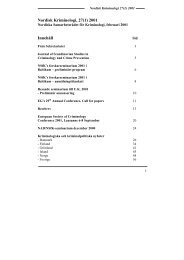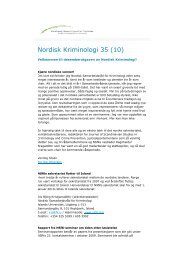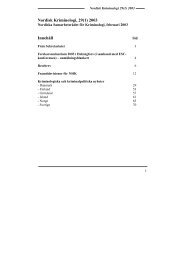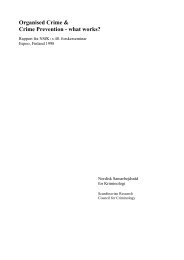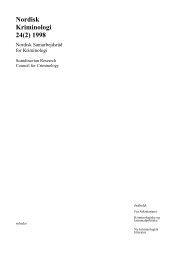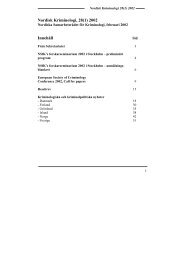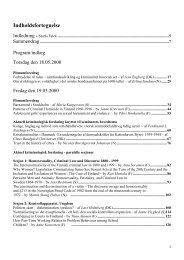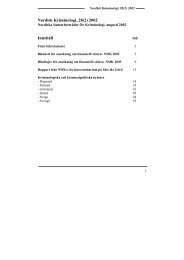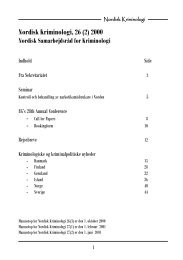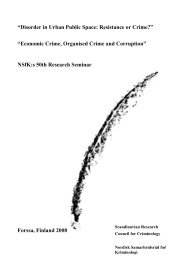NSfK:s 47th Research Seminar Oslo, Norway 2005 - Scandinavian ...
NSfK:s 47th Research Seminar Oslo, Norway 2005 - Scandinavian ...
NSfK:s 47th Research Seminar Oslo, Norway 2005 - Scandinavian ...
Create successful ePaper yourself
Turn your PDF publications into a flip-book with our unique Google optimized e-Paper software.
In cross tabulation are Chi-Square Tests used to analyse if significant differences are found<br />
between groups. Multiple regression analysis were performed to determine what can predict if<br />
youth are offered drugs or not. Following variables were entered into the model by step-wise<br />
method and enter-method: gender; age; residence, in school, working, unemployed, schooling,<br />
participation in somekind of education over the past 12 months, attitude toward the police,<br />
and drug use, smoking and alcohol consumption over the past 12 months. The variables that<br />
can predict if youth are offered drugs are: drug use and smoking over the past 12 months,<br />
gender, attitude toward the police and schooling, they were dichotomized variables. The final<br />
model are based on enter-method. Two outlayers that were more than three standard division<br />
from the mean were excluded. This model was also tested by multinominal logistic<br />
regression.<br />
Multiple logistic regression analysis were performed to determine whether participation in<br />
Police Prevention Programmes was significant factor in drug-use other than hash or marijuana<br />
(0=never or seldom used other drugs; 1=sometimes or often used other drugs than hash or<br />
marijuana) when controlling for gender, schooling and attitude to police. Each of the<br />
independent variables, except attitude to police, was entered as a dichotomized variable. Two<br />
outlayers that were more than three standard division from the mean were excluded. The<br />
model is based on enter-method.<br />
Conclusions<br />
Alcohol consumption and drug use<br />
About 12% of the participants had used hash or marijuana over the past 12 months and 7%<br />
other drugs. Based on these questions it can be concluded that about 13% of young people,<br />
age 18-20 years old, had used drugs over the past 12 months, more males (19%) than females<br />
(8%). About 22% of the participants that drop-out of upper secondary school or not attend<br />
upper secondary school had used drugs over the past 12 months but 11% of the participants<br />
that were in upper secondary school, had completed upper secondary school or other. About<br />
91% had drunk alcohol over the past 12 months. There is not significant differences by gender<br />
or schooling between those that have drink alcohol and those that have not drink alcohol.<br />
Access to drugs<br />
Here are introduced the measurement that is called “Access to drugs” in order to understand<br />
better the situation our youth are living in, in our Society, it is important to try to understand<br />
the situation better than have been done in Iceland. According to Police Reports increase are<br />
in reported narcotic cases over the last years (Reykjavik Police, 2004). <strong>Research</strong>es have<br />
shown that by making it easier to buy alcohol increases the consumption of alcohol<br />
(Lýðheilsutöð, <strong>2005</strong>) and that 75% of youth 12-18 years old that had use alcohol or tobacco<br />
reported an opportunity to try marijuana by age 18, and more than 85% of them made the<br />
transition to marijuana use. Only about 25% of nonsmokers and nondrinkers were given an<br />
opportunity to try marijuana by the same age (Martin, 2002/2003). Therefore easy access to<br />
drugs can probably increase drug use.<br />
Results from this research shows that among youth 18-20 years old in Iceland about 18% had<br />
often been offered drugs, about 14% sometimes, about 30% seldom and about 38% never.<br />
Significant differences are by gender and schooling (see table 1).<br />
22


